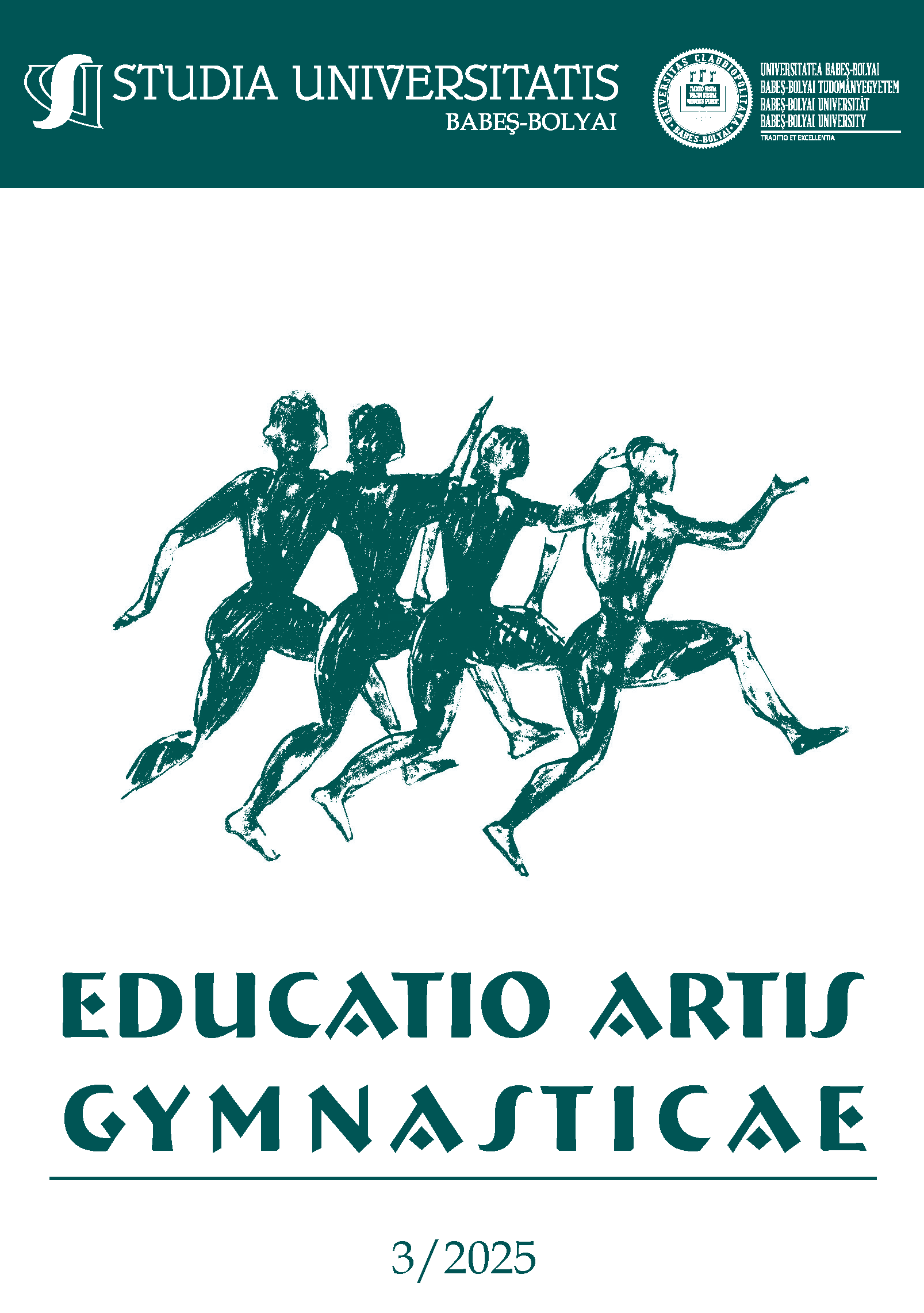The Effectiveness of Blazepod-Based Neurocognitive Training on Reaction Time and Agility in Young Competitive Athletes
DOI:
https://doi.org/10.24193/subbeag.70(3).25Keywords:
reaction time, neurocognitive training, agility, BlazePod, adolescent athletesAbstract
Introduction: Reaction speed and cognitive-motor coordination are critical components of athletic performance, particularly in sports requiring rapid decision-making and stimulus-response adaptation. While BlazePod technology has gained popularity in applied settings, empirical validation in youth athletic populations remains limited. Objective: This study aimed to evaluate the effects of a six-week BlazePod-based neurocognitive training program on reaction time, agility, and cognitive-motor performance in adolescent athletes. Methods: Thirty-five athletes (aged 15–19) were randomly assigned to experimental (n = 18) or control (n = 17) groups. The experimental group received additional BlazePod training (3 sessions/week, 15–20 minutes), while the control group continued standard sport-specific routines. All participants completed five tests at pre- and post-intervention: Simple Reaction Time, Choice Reaction Time, Agility T-Test, Go/No-Go, and Stroop Response Time. Results: Statistically significant improvements were observed in all variables within the experimental group (p < .001), with large effect sizes (Cohen’s d > 2.0). The control group showed smaller but significant gains. Gender-based analysis confirmed training effectiveness across both sexes. Conclusions: BlazePod-based training significantly enhances both motor and cognitive performance in youth athletes. The results support its integration into sport training to improve reactivity, executive function, and decision-making under pressure.
Article history: Received 2025 August 21; Revised 2025 October 08; Accepted 2025 October 23;
Available online 2025 November 20; Available print 2025 November 30
References
Barha, C. K., Davis, J. C., Falck, R. S., Nagamatsu, L. S., & Liu-Ambrose, T. (2017). Sex differences in exercise efficacy to improve cognition: A systematic review and meta-analysis of randomized controlled trials in older humans. Frontiers in Neuroendocrinology, 46, 71–85. https://doi.org/10.1016/j.yfrne.2017.04.002
Blain, B., Longman, D., & Ward, J. (2020). Gender differences in executive function: Evidence from adolescents. Cognitive Development, 55, 100931. https://doi.org/10.1016/j.cogdev.2020.100931
Broadbent, D. P., Causer, J., Ford, P. R., & Williams, A. M. (2015). Perceptual-cognitive skill training and its transfer to expert performance in the field: Future research directions. European Journal of Sport Science, 15(4), 322–331. https://doi.org/10.1080/17461391.2014.957727
Campanella, M., Cardinali, L., Ferrari, D., Migliaccio, S., Silvestri, F., Falcioni, L., Bimonte, V. M., Curzi, D., Bertollo, M., Bovolon, L., Gallotta, M. C., Guidetti, L., Baldari, C., & Bonavolontà, V. (2024). Effects of Fitlight training on cognitive-motor performance in élite judo athletes. Heliyon, 10(7), e28712. https://doi.org/10.1016/j.heliyon.2024.e28712
De Fazio, R., Mastronardi, V. M., De Vittorio, M., & Visconti, P. (2023). Wearable Sensors and Smart Devices to Monitor Rehabilitation Parameters and Sports Performance: An Overview. Sensors, 23(4), 1856. https://doi.org/10.3390/s23041856
Faubert, J., & Sidebottom, L. (2012). Perceptual-cognitive training of athletes. Journal of Clinical Sport Psychology, 6(1), 85–102. https://doi.org/10.1123/jcsp.6.1.85
Gabbett, T., & Benton, D. (2009). Reactive agility of rugby league players. Journal of Science and Medicine in Sport, 12(1), 212–214. https://doi.org/10.1016/j.jsams.2007.08.011
Lloyd, R. S., & Oliver, J. L. (2012). The youth physical development model: A new approach to long-term athletic development. Strength & Conditioning Journal, 34(3), 61–72. https://doi.org/10.1519/SSC.0b013e31825760ea
Malina, R. M., Rogol, A. D., Cumming, S. P., Coelho e Silva, M. J., & Figueiredo, A. J. (2015). Biological maturation of youth athletes: Assessment and implications. British Journal of Sports Medicine, 49(13), 852–859. https://doi.org/10.1136/bjsports-2015-094623
Mann, D. T. Y., Williams, A. M., Ward, P., & Janelle, C. M. (2007). Perceptual-cognitive expertise in sport: A meta-analysis. Journal of Sport and Exercise Psychology, 29(4), 457–478. https://doi.org/10.1123/jsep.29.4.457
Scharfen, H. E., & Memmert, D. (2019). Measurement of cognitive functions in experts and elite athletes: A meta-analytic review. Applied Cognitive Psychology, 33(5), 843–860. https://doi.org/10.1002/acp.3531
Silvestri, F., Campanella, M., Bertollo, M., Albuquerque, M. R., Bonavolontà, V., Perroni, F., Baldari, C., Guidetti, L., & Curzi, D. (2023). Acute Effects of Fitlight Training on Cognitive-Motor Processes in Young Basketball Players. International journal of environmental research and public health, 20(1), 817. https://doi.org/10.3390/ijerph20010817
Verburgh, L., Scherder, E. J., Van Lange, P. A., & Oosterlaan, J. (2014). Executive functioning in highly talented soccer players. PLoS ONE, 9(3), e91254. https://doi.org/10.1371/journal.pone.0091254
Voss, M. W., Kramer, A. F., Basak, C., Prakash, R. S., & Roberts, B. (2010). Are expert athletes ‘expert’ in the cognitive laboratory? A meta-analytic review of cognition and sport expertise. Applied Cognitive Psychology, 24(6), 812–826. https://doi.org/10.1002/acp.1588
Wulf, G., & Lewthwaite, R. (2016). Optimizing performance through intrinsic motivation and attention for learning: The OPTIMAL theory of motor learning. Psychonomic Bulletin & Review,
Williams, A. M., & Ford, P. R. (2008). Expertise and expert performance in sport. International Review of Sport and Exercise Psychology, 1(1), 4–18. https://doi.org/10.1080/17509840701836867
Downloads
Published
How to Cite
Issue
Section
License
Copyright (c) 2025 Studia Universitatis Babeş-Bolyai Educatio Artis Gymnasticae

This work is licensed under a Creative Commons Attribution-NonCommercial-NoDerivatives 4.0 International License.



